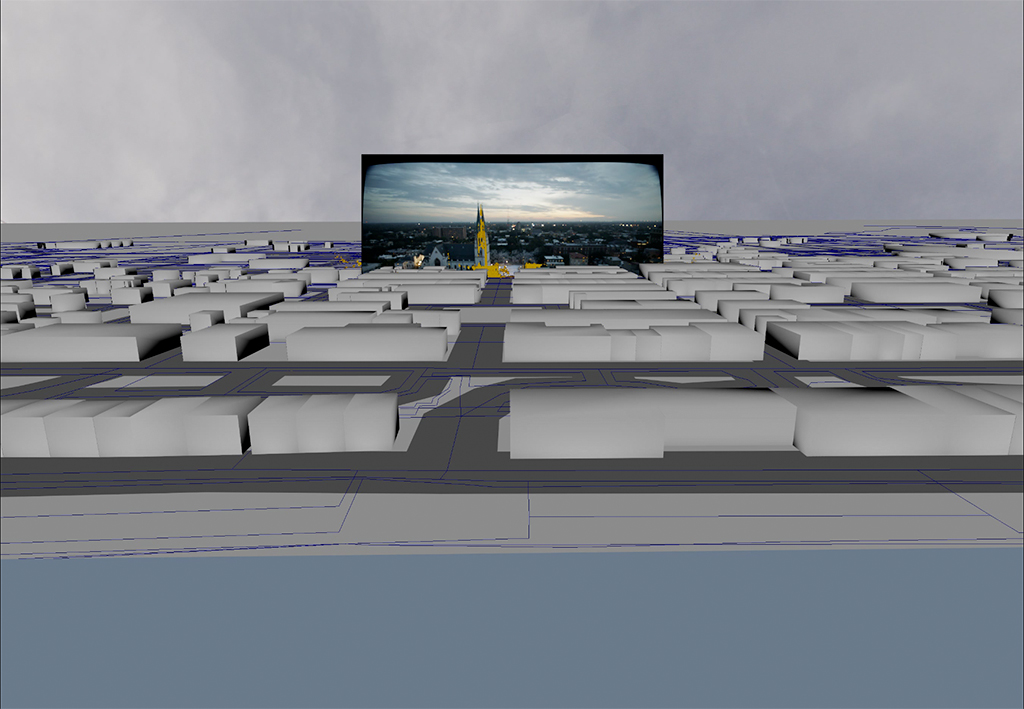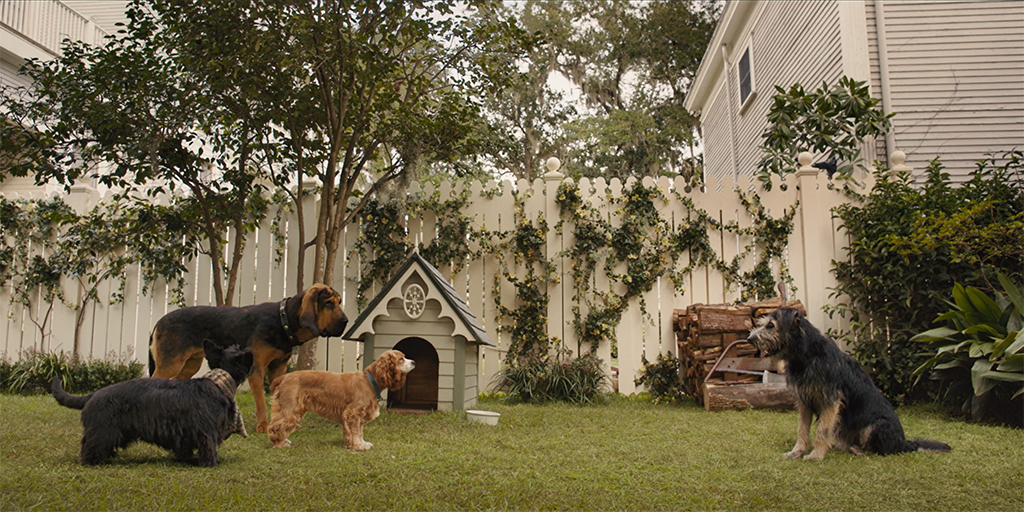By TREVOR HOGG
By TREVOR HOGG
A romance that blossoms between a domesticated Cocker Spaniel and a homeless mutt in the animated classic Lady and the Tramp gets a live-action treatment under the direction of Charlie Bean and digital expertise of Visual Effects Supervisor Robert Weaver for Disney+. “A great deal of time went into casting what would be considered the appropriate character based on Lady, Tramp and the incidental dogs,” states Weaver. “So much so that Charlie was completely satisfied with the embodiment of those dogs personifying the movie characters.
“Everything that we shot was with the practical dog, not only because it would buy us all kinds of information for lighting reference, I knew that there would be many occasions that the action they were doing was to the liking of the director, and if only we could train the dogs to talk we would have got everything in-camera. For me, that was a great comfort because we had a real target. Shows can get into trouble if it’s not clear to the creatives what that character is meant to embody.


“Rose was such a sweet dog that Charlie instantly fell in love with her and thought that she captured the essence of Lady aside from talking,” notes Weaver. “We learned what the idiosyncrasies of each individual character were and built that into the overall choreography performance of the body or closer to the facial capture. The dogs couldn’t emote quite the way we needed them to because we had to add language and with that comes a stronger sense of emotion. If Lady was bursting out laughing what would that be? Going through all of the footage we realized that when Rose was hot and panting it looked exactly like she was laughing. We cued off of that and took it a step or two further depending on the need.”

Multiple dogs were utilized for the main cast members. “We had the hero for the closeups, and if there was any action required then we would typically have a stunt double. I would give a large appreciation to Mark Forbes and his team because what they were able to accomplish through training was remarkable. It exceeded my expectations in almost every area. For the spaghetti scene when Lady and Tramp are sitting down and there is the cute push over of the last meatball by Tramp to Lady, they trained Monte who was Tramp to actually do that and he was phenomenal. It was brilliant reference that couldn’t be used in the final because we had to add more to the action.”
A significant amount of the final footage was captured practically. “We were fortunate in the training and selection of the dogs to be able to capture all the nonvisual effects without issue,” reveals Weaver. “Then in the visual effects world we were able to get away with 25% to 30% of the real dog’s actions where we could be satisfied with rotomating the dog and replacing a CG version that looked exactly like the live-action dog, except that they had to focus in one type of performance or adding dialogue. The hero dogs were built to the fidelity, so the camera could be inches away and it would be photorealistic.
“No expense was spared in the details that we did on Lady, Tramp, Peg and Bull,” adds Weaver. “They were full 3D models. These dogs could be oriented in any fashion to camera and would hold up fine.” No major issues were had with the fur simulations. “We had one sequence on top of the ferryboat where the real dogs were up there for reference and leashed down for safety. Replicating how the wind moved across the fur was difficult, but nothing that was excruciating or painful. These days most of the main houses doing visual effects work have engines that are capable of doing photorealistic simulations of fur in a short order, but it’s mostly due to the artistic endeavors that make it believable. It either comes together easily or not easily depending on that person’s sensibility.”


“Everything that we shot was with the practical dog, not only because it would buy us all kinds of information for lighting reference, I knew that there would be many occasions that the action they were doing was to the liking of the director, and if only we could train the dogs to talk we would have got everything in-camera. For me, that was a great comfort because we had a real target. Shows can get into trouble if it’s not clear to the creatives what that character is meant to embody.”
—Robert Weaver, Visual Effects Supervisor



“[I]n the visual effects world we were able to get away with 25% to 30% of the real dog’s actions where we could be satisfied with rotomating the dog and replacing a CG version that looked exactly like the live-action dog except that they had to focus in one type of performance or adding dialogue. The hero dogs were built to the fidelity so the camera could be inches away and it would be photorealistic.”
—Robert Weaver, Visual Effects Supervisor



Numerous storyboards were produced for the project. “Charlie comes from an animation background, so he worked in such a fashion that everything got boarded out,” remarks Weaver. “Once it was boarded, we put animatics in place. Previs was used in a limited capacity primarily for the hillside environment which we knew was going to be completely CG. Postvis was done extensively on every shot so we could give the houses a clear direction during turnover as to the expectations.” On-set stuffies enabled the shot to be composed before the real dogs were brought in and subsequently a clean pass was captured. “The only other addendum to that is there were times where the dogs couldn’t be together,” explains Weaver. “If one dog had an aggressive action to portray and there was another dog present, we could only have the one dog at a time. It would be a split composite if we were able to get both in-camera.”



“Everybody had the confidence that it would be indistinguishable between the CG and live-action dogs. I worked hand-in-hand with stunts and special effects departments. As always, safety is rule number one. If there was ever a question, I would come up with a post solution to accomplish what needed to be done, whether we needed to create a digital double or add all kinds of debris from the wagon tipping over. I gave the departments the latitude to create what they could in-camera and wherever necessary CG would take over.”
—Robert Weaver, Visual Effects Supervisor
Principal photography took place in Savannah, Georgia. “We were only on set for some of the interior house scenes and the rest was on location in various parts of the city,” states Weaver. “If there were any safety issues the dogs wouldn’t be present. We would say that is going to be a CG dog. Everybody had the confidence that it would be indistinguishable between the CG and live-action dogs. I worked hand-in-hand with stunts and special effects departments. As always, safety is rule number one. If there was ever a question, I would come up with a post solution to accomplish what needed to be done, whether we needed to create a digital double or add all kinds of debris from the wagon tipping over. I gave the departments the latitude to create what they could in-camera and wherever necessary CG would take over.”

Lady and the Tramp features 1,150 visual effects shots that were created over nine months, with the main vendors being Framestore and Weta Digital with MPC being brought in later on during the post-production process. “Framestore built Lady and Weta Digital built Tramp,” states Weaver. “The houses would share as few assets as necessary. Lady and Tramp needed to be shared because they were in almost every shot, but Peg and Bull were in Weta Digital’s court. We were smart about how we divvied up the work so we didn’t have to match another house’s asset. If two people do the same asset it is difficult to make them look and feel as the same character.

“One of the biggest challenges was to convey a sense of character in a dog without going anthropomorphic because that starts getting creepy fast,” remarks Weaver. “Likewise, a lack of emotional response can lead to a deadpan performance which nobody wants either. It was teetering on that balance of how much do we personify the characters into the dogs. The voice actors’ performance was captured with witness cameras. If you looked at the footage you would see a facial contortion, and the way that this eyebrow raised was cool. We tried to put aspects of that into the actual dogs. That was a great challenge to put it all into the melting pot and hope that it comes out believable.”